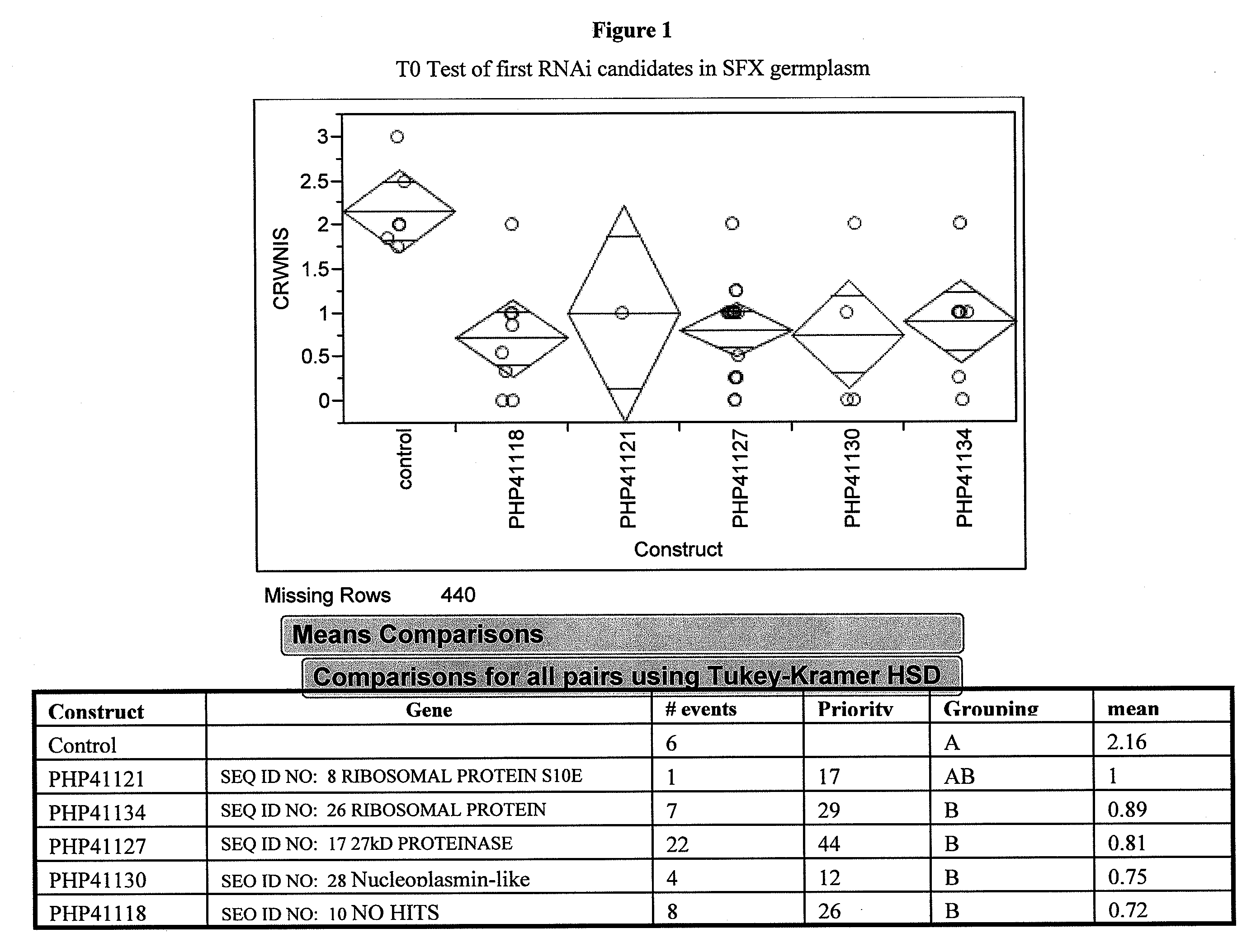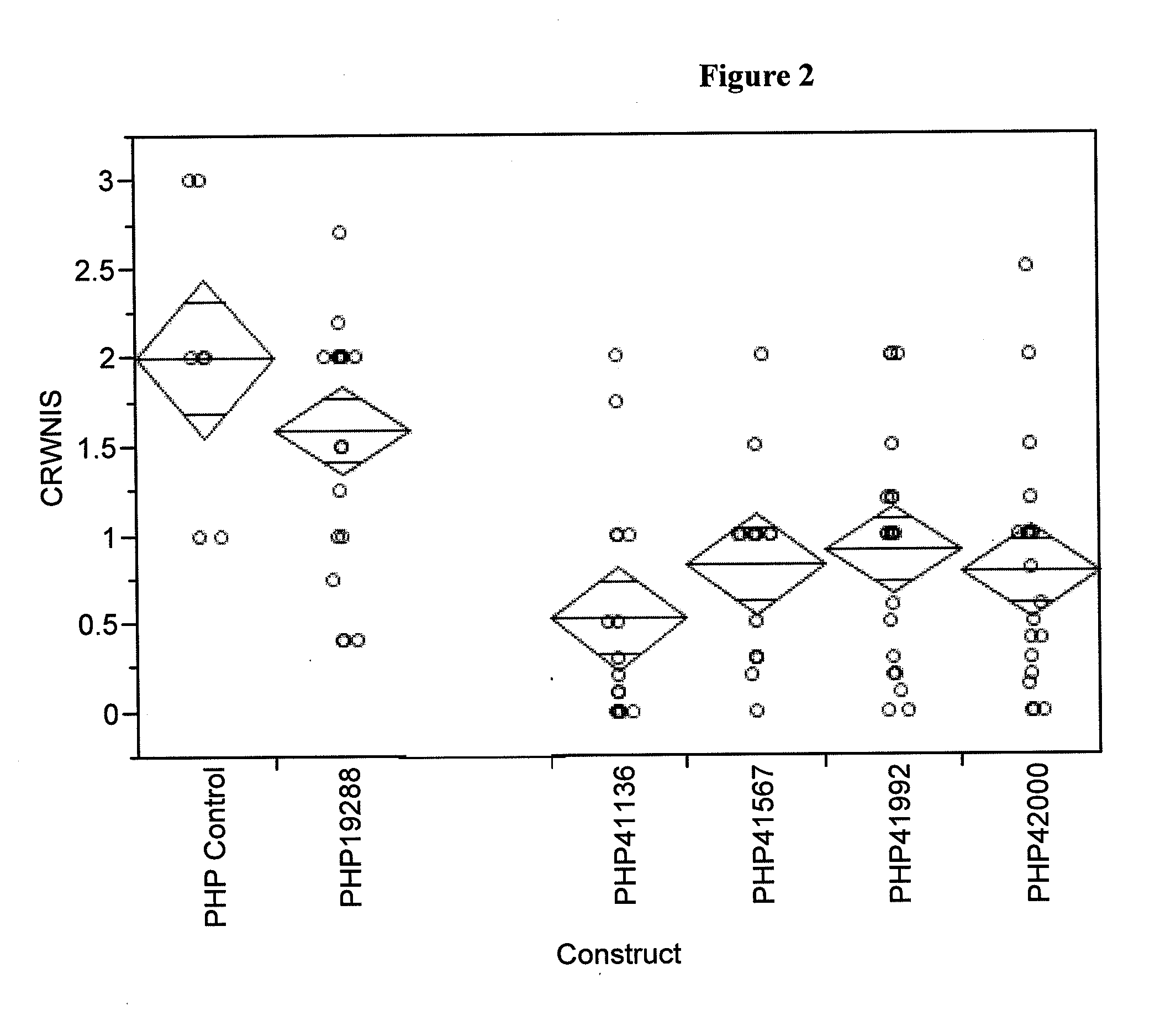Compositions and methods to control insect pests
- Summary
- Abstract
- Description
- Claims
- Application Information
AI Technical Summary
Benefits of technology
Problems solved by technology
Method used
Image
Examples
example 1
In Vitro Transcript dsRNA Screening Method
[0119]A cDNA library was produced from neonate western corn rootworm larvae by standard methods. A selected cDNA clone containing an expressed sequence tag is amplified in a PCR using universal primers to the plasmid backbone and flanking the EST insert. The universal primers also contain T7 RNA polymerase sites. 1 ul of the PCR reaction is used as the template for an in vitro transcription (IVT) reaction to produce long double stranded RNAs. Following enzymatic digestion and removal of the DNA template and single stranded RNA, the IVT reaction products are incorporated into artificial insect diet as described below.
Insect Bioassays
[0120]2.5 ul of the IVT reaction are added to a given well of a 96 well microtiter plate. 25 ul of molten lowmelt Western corn rootworm diet are added to the sample and shaken on an orbital shaker to mix the sample and diet. Once the diet has solidified, neonate rootworms are added to the well. An average of 5 neo...
example 2
Sequences Having Insecticidal Activity
[0122]DNA sequences which encode double stranded RNAs which were shown to have insecticidal activity against corn rootworms using the assay described in Example 1 are set forth below. Non-limiting examples of target polynucleotides are set forth below in Table 1.
TABLE 1SEQ ID NO: 1>iwm2c.pk005.e1.fis1SEQ ID NO: 2>iwm2c.pk004.b13.fis1SEQ ID NO: 3>iwm2s.pk003.o11.fis1SEQ ID NO: 4>iwm2c.pk002.e24.fis1SEQ ID NO: 5>iwm2c.pk002.e24.fis1SEQ ID NO: 6>iwm2c.pk011.n17.fis1SEQ ID NO: 7>idv1c.pk001.d14.f.fis1SEQ ID NO: 8>idv1c.pk001.e9.f.fis1SEQ ID NO: 9>idv1c.pk001.m5.f.fis1SEQ ID NO: 10>idv1c.pk001.n1.f.fis1SEQ ID NO: 11>idv1c.pk002.c5.f.fis1SEQ ID NO: 12>idv1c.pk002.f20.f.fis1SEQ ID NO: 13>idv1c.pk002.j17.f.fis1SEQ ID NO: 14>idv1c.pk002.n13.f.fis1SEQ ID NO: 15>idv1c.pk003.d6.f.fis1SEQ ID NO: 16>idv1c.pk003.f8.f.fis1SEQ ID NO: 17>idv1c.pk003.f9.f.fis1SEQ ID NO: 18>idv1c.pk003.j4.f.fis1SEQ ID NO: 19>idv1c.pk003.j6.f.fis1SEQ ID NO: 20>idv1c.pk003.j20.f.fis1...
example 3
Transformation of Maize
[0123]Immature maize embryos from greenhouse donor plants are bombarded with a plasmid containing the silencing element of the invention operably linked to either a tissue specific, tissue selective, or constitutive promoter and the selectable marker gene PAT (Wohlleben et al. (1988) Gene 70:25-37), which confers resistance to the herbicide Bialaphos. In one embodiment, the constructs will express a long double stranded RNA of the target sequence set forth in table 1. Such a construct can be linked to the dMMB promoter. Alternatively, the selectable marker gene is provided on a separate plasmid. Transformation is performed as follows. Media recipes follow below.
Preparation of Target Tissue
[0124]The ears are husked and surface sterilized in 30% Clorox bleach plus 0.5% Micro detergent for 20 minutes, and rinsed two times with sterile water. The immature embryos are excised and placed embryo axis side down (scutellum side up), 25 embryos per plate, on 560Y medium...
PUM
| Property | Measurement | Unit |
|---|---|---|
| Fraction | aaaaa | aaaaa |
| Fraction | aaaaa | aaaaa |
| Fraction | aaaaa | aaaaa |
Abstract
Description
Claims
Application Information
 Login to View More
Login to View More - R&D
- Intellectual Property
- Life Sciences
- Materials
- Tech Scout
- Unparalleled Data Quality
- Higher Quality Content
- 60% Fewer Hallucinations
Browse by: Latest US Patents, China's latest patents, Technical Efficacy Thesaurus, Application Domain, Technology Topic, Popular Technical Reports.
© 2025 PatSnap. All rights reserved.Legal|Privacy policy|Modern Slavery Act Transparency Statement|Sitemap|About US| Contact US: help@patsnap.com


